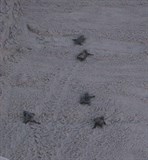
Hatchlings rule!
Although our turtle mamas are still technically “on the clock” with the official nesting season continuing through this month it’s their babies that have taken over the spotlight. We’re still hoping for at least sixty nests but for now hatchlings rule. With the patter of thousands of tiny flippers on Topsail it’s time for a quick review of some of the FAQ’s from our island visitors.
When will a nest hatch? By far it’s the question we’re asked the most, and no matter how many times we get it our answer is still the same: we don’t know. We’re not being maliciously obtuse, it’s the truth. We don’t know when these turtle babies will be “born” any better than you know exactly the date and time of your granddaughter’s birth. They come out whenever they’re ready.
How long do the eggs stay in the sand? The average incubation period is sixty days, but that’s only an average. Air and sand temperature can affect the actual incubation period with hotter sand sometimes speeding up the process. We’ve had a very hot summer along with a lot of rain so there’s no telling what effect that combination of weather will have on the incubation period. As we move into the cooler fall temperatures (we hope they’re cooler, anyway) their time in the sand might be a little longer.
Is there any way to guess when a nest is ready? Sort of. Obviously the first thing to look at is when the nest was laid and when those sixty days might be getting close. But it’s not like mom leaves a calendar with the date circled with her clutch. Like people, you have early risers. And once they break out of their shell, using a special adaptation referred to as their “egg tooth” (technical name caruncle) they start jostling their neighbors out of their slumber. Pretty soon everybody is up and kicking. All of that activity underneath causes the sand on the surface to begin to sink.
If it looks like a nest may hatch what else can I look for? Turtle Project volunteers will create a ramp, a smoothed area with sand “guardrails” that will hopefully guide the little critters safely in the direction of the surf. Hatchlings are so tiny that even a small footprint in the sand can trap them or delay their trip. And since they’ve been living in the dark for months any bright light can disorient them, sending them quickly off-course. They head toward the brightest object around which ideally is the moon and its reflection on the water and waves. A sure sign that a nest is close, at least according to our decades of experience, is the sight of our “nest sitters” huddled around a nest from dusk until the wee hours of the morning – hoping.
What happens during a hatch? It’s a group effort, a real family affair, at least for the turtles. They work together to battle through the broken shells and the constant flipper-in-the-face to make their way towards the surface. It’s dig and rest, dig and rest. As they near the top the group comes to a stop and waits just below the surface. Millions of years of existence as a species have told them that predatory attack is less likely at night, so they’re waiting for the sun to set and the sand temperature at the surface to cool down. At that point they emerge in mass in what we call a “boil.” If all goes well they locate the horizon and make a mad dash for the surf.
Why are the Turtle Project volunteers there? From the 1970’s Karen Beasley and her mother (our hospital Director, Jean) recognized the increasing stressors of coastal development and the natural affinity we all have for the sea and the impact on sea turtles. Our volunteers are there to minimize any adverse effects we humans may have on this critical step in the continuation of the species. These are federally protected and critically endangered animals, and when our “nest sitters” are on-the-job they are the final word on protocol. They are there for crowd control and for education and there are specific rules to follow if you are fortunate enough to actually see a nest hatch.
Sit quietly, away from the nest and ramp area. It may or may not boil, and if it does it may be hours before you see the first flipper. If you become impatient please step away.
Do not use flash photography or use your phone as a “flashlight.” Do not use any flashlight unless you have a special red filter. Ideally you should turn your phone off and pay attention to the miracle you’re about to see.
- Keep children and yourself away from the nesting area. Do not wander near or in front of the ramp. Do not bring your pets with you.
- Do not chase after or touch the hatchlings. Our volunteers are on-hand to redirect any hatchlings who stray off course.
I missed the hatch – am I out of luck? Not necessarily. If you’re going to be around for a while you can come to the nest analysis which is done during daylight hours, three days after the hatch. Volunteers will carefully excavate the nest and document their findings. And the “findings” will often include a few late risers who didn’t hear the alarm go off. Data collected will include the total number of eggs (including unhatched,) the number of live hatches and any other things of note. If you missed the boil this is the next best thing and worth your time. Our volunteers are a bit more relaxed you can still ask them any questions you may have.
What do I do if I find a hatchling on the beach? Carefully pick it up and put it in a small container with only a small amount of water - barely cover the flippers. With this extreme heat it’s important that the little critter not bake in the sun for hours. Then call our Director of Beach Operations, Terry Meyer at: 910-470-2880. If she is not available you may call the hospital during operating hours: 910-329-0222. We will take the information and one of our area coordinators will meet you to retrieve the hatchling and refer it to us for follow-up.
Anything else? Some obvious things: turn off any bright outdoor lights that would send hatchlings in the wrong direction; pick up all beach paraphernalia (chairs, toys, towels) and take it with you when you leave and fill in any holes you dig. Please do not call the hospital to ask about any specific nest – we don’t have the data in front of us and are unable to answer that question. While some of our volunteers are busy with the babes on the beach our hospital staff is occupied working with the survivors. Visit us during tour hours to see the ones who actually made it because so few do.
We’re still on our summer tour schedule, open daily (EXCEPT Wednesdays and Sundays) from Noon – 4 PM for the next month or so. In mid-September we go to our fall/winter schedule of two days a week. Attendance averages between 800 and 1,200 visitors a day so lines can be long at times. Bring umbrellas for shade and lots of water to stay hydrated. The tour takes about 30-40 minutes once inside the doors so plan your schedule accordingly. Hope to see you all soon – we love “talking turtle.”



